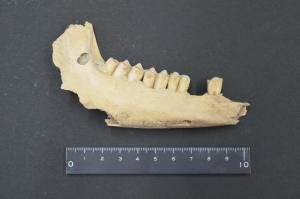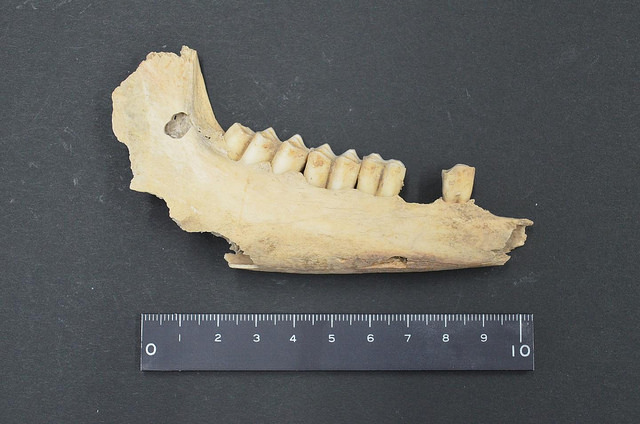
NAGOYA UNIVERSITY—Nagoya, Japan – Domestic goats first appeared in the Fertile Crescent, in modern-day Iran and Turkey, around 10,000 years ago through domestication of the Bezoar wild goat. However, as this wild goat species is distributed across a large part of the Middle East, it is still unclear whether all domestic goats in this region descend from a single domestication event, or if multiple domestications occurred.
A research team based at Nagoya University and including members in Tokyo and Azerbaijan has revealed that goats were first introduced into the Southern Caucasus, in present-day Azerbaijan, from the Fertile Crescent around 7,500-8,000 years ago. This finding corresponds with archeological evidence showing sudden large cultural changes associated with the introduction of agriculture in this area.
Genetic sequencing technology combined with the ability to extract and isolate ancient DNA lets researchers obtain detailed information about ancient organisms, and compare them with their modern equivalents. This is particularly useful for studying animal and plant domestication and finding wild species that are the ancestors of present-day domestic animals and plants. The research team focused this technology on domestic goats, building on earlier findings about their main wild ancestor, and the location and timing of their initial domestication, to provide more details about how goats were distributed throughout the Middle East.
In the study*, reported in the International Journal of Osteoarchaeology, the researchers extracted and sequenced DNA from goat bones obtained from excavations at early agricultural settlements in Azerbaijan, and which radiocarbon dating revealed to be 7,500-8,000 years old. They then compared the DNA sequences with those of present-day domestic and wild goats from the same geographic region, as well as those of other Neolithic goats reported in previous studies.
“Our analysis of mitochondrial DNA showed that the haplotypes of the present-day and Neolithic domestic goats in the Southern Caucasus matched,” co-author Keiko Ohnishi says. “Yet they didn’t match the haplotype of the wild goats of the same region, suggesting that these wild goats are not the ancestors of the region’s domestic goats. The genetic match between domestic goats in the Southern Caucasus and wild goats in the Fertile Crescent suggests goats were not domesticated independently in the Caucasus, but rather that already-domesticated goats were introduced.”
_______________________________________
Ancient goat bone used for DNA analyses (from Göytepe). Credit: Seiji Kadowaki
_________________________________________
By combining the genetic results with archeological findings from excavations at the two sites in west Azerbaijan, the research team also drew some wider conclusions about a period of relatively rapid social change in the region.
“The sites where these bones were found are the earliest agricultural settlements in the Caucasus. Other novel signs of agriculture and cultural artifacts also suddenly started to appear in what were hunting-and-gathering areas,” lead author Seiji Kadowaki says. “This ties in well with the introduction of domesticated goats from the Fertile Crescent around the same time, suggesting that populations moved or indigenous hunter-gatherers in the Caucasus accepted agricultural lifestyles from the Fertile Crescent about 7,500-8,000 years ago.”
The study provides useful information about the spread of agriculture and domesticated animals throughout the Middle East, which appears to have been accompanied by the spread of other cultural practices. It also provides a foundation for further studies unravelling the relative contributions of human population movements and the adoption of novel practices by indigenous groups to the spread of domesticated animals.
Source: Nagoya University news release
______________________________________________________
*The article “Mitochondrial DNA Analysis of Ancient Domestic Goats in the Southern Caucasus: A Preliminary Result from Neolithic Settlements at Göytepe and Hac? Elamxanl? Tepe” was published in the International Journal of Osteoarchaeology at doi: 10.1002/oa.2534
______________________________________________________

______________________________________________
Travel and learn with Far Horizons.
____________________________________________
This richly illustrated issue includes the following stories: Recent findings shedding new light on the whereabouts of the remains of Philip of Macedon, father of Alexander the Great; how an archaeologist-sculptor is bringing bones of the dead back to life; archaeologists uncovering town life at the dawn of civilization; an exclusive interview with internationally acclaimed archaeologist James M. Adovasio about what makes the Meadowcroft Rockshelter prominent in the ongoing search for the first Americans; what archaeologists are finding at the site of the ancient city of Gath, the home town of the biblical Philistine giant, Goliath; and how scientists are redrawing the picture of human evolution in Europe. Find it on Amazon.com.









